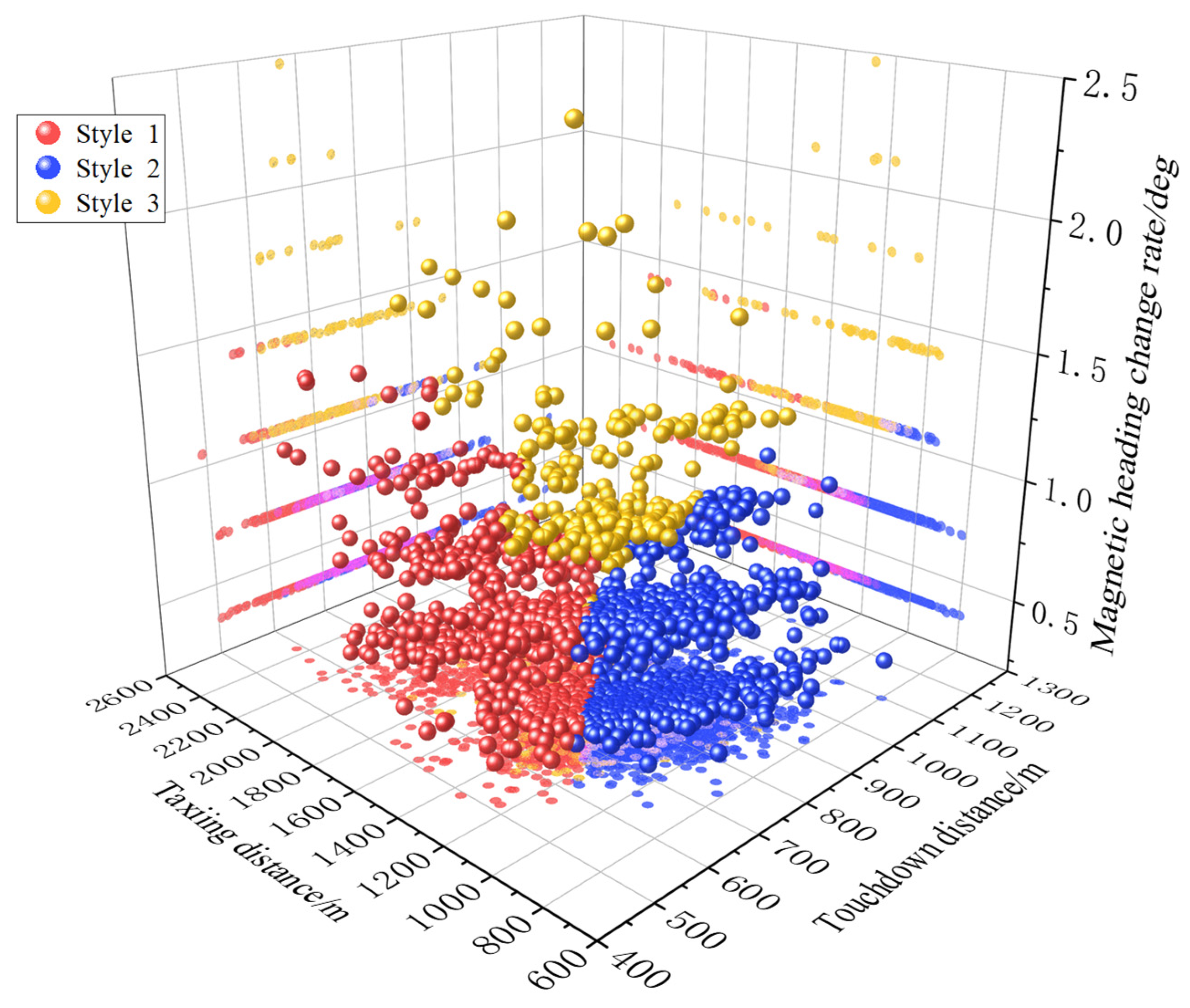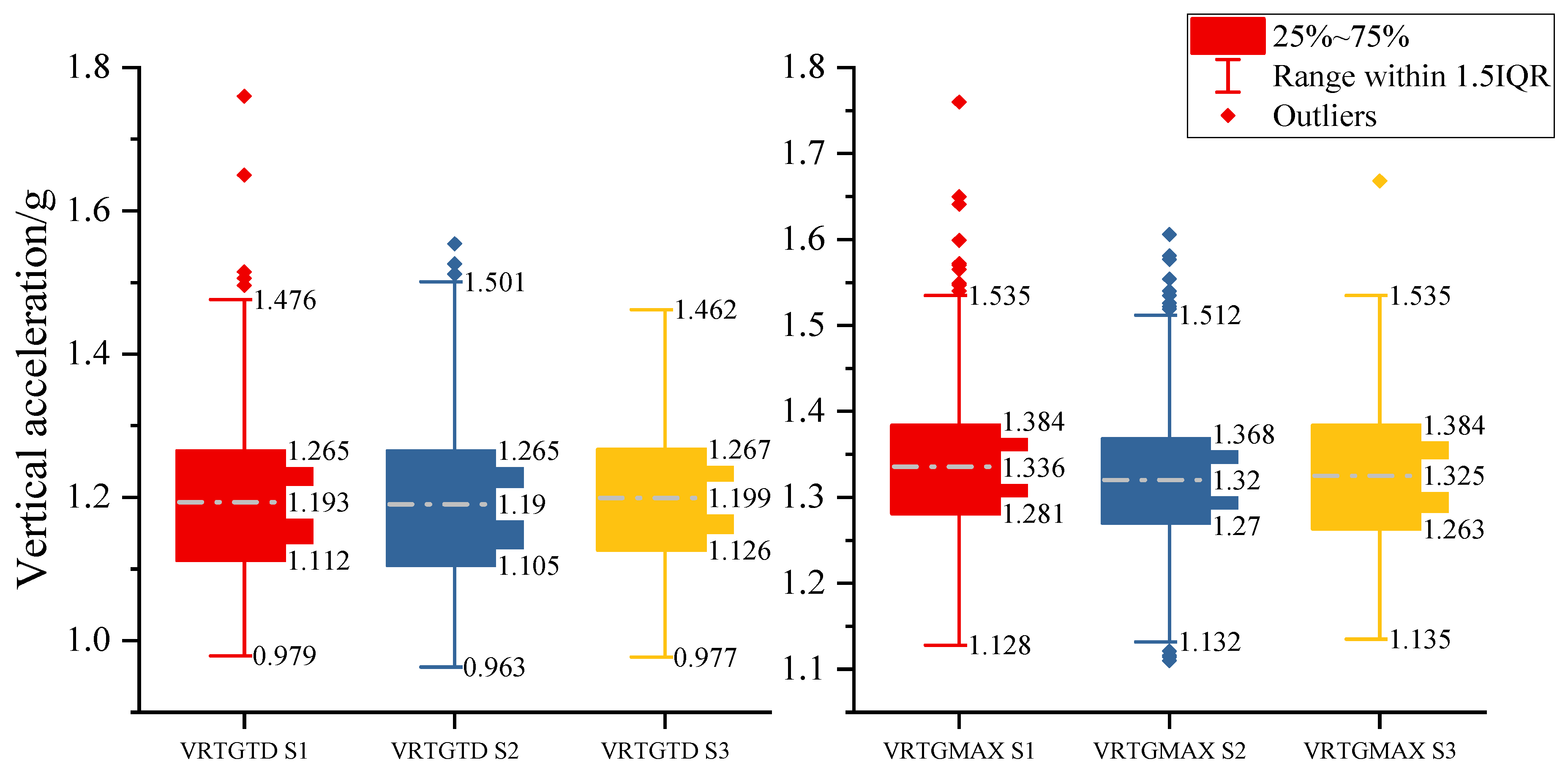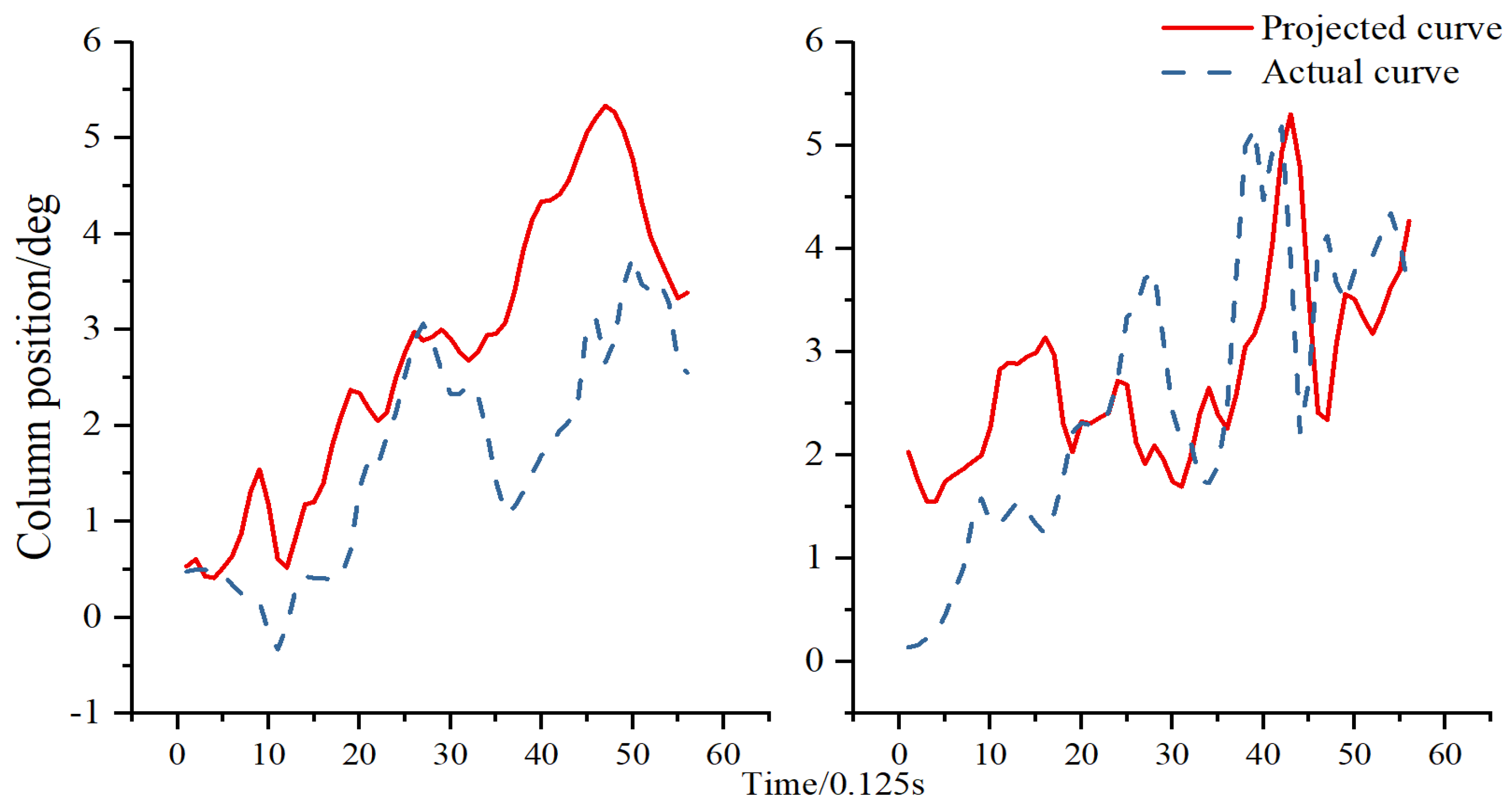Impacts of Flight Operations on the Risk of Runway Excursions
Abstract
1. Introduction
2. Related Work
2.1. Runway Excursion
2.2. Other Flight Safety Studies
3. Classification of Operating Styles
3.1. Data Processing
3.2. K-Means ++ Cluster Analysis
4. Operational Analysis of Crucial Stages
4.1. Runway Threshold
4.2. Moment of Flare and Speed Brake On
4.3. Touchdown Moment and Reverse Thrust On
4.4. Holistic Analysis
5. Calculation and Analysis of Curve Similarity
5.1. Standard Curve Filtering
5.2. Curve Similarity Calculation
5.3. Flare Stage Prediction Curves
5.4. Typical Correlation Analysis
6. Conclusions
Author Contributions
Funding
Institutional Review Board Statement
Informed Consent Statement
Data Availability Statement
Conflicts of Interest
Abbreviations
| MDPI | Multidisciplinary Digital Publishing Institute |
| QAR | Quick Access Recorder |
| IATA | International Air Transport Association |
| SHELLO | Software; Hardware; Environment; Liveware; Other Liveware; Organization |
| GTT | Greedy Thick Thinning algorithm |
| IMTCN | Interpretable Multi-scale Temporal Convolutional Networks |
| LSTM-DNN | Long Short-Term Memory and Deep Neural Networks |
| ACARS | Aircraft Addressing and Reporting System |
| VRTG | Vertical Acceleration |
| SSR | Sum of Squared Residuals |
| SST | Total Sum of Squares |
References
- IATA. IATA Safety Report 2021; IATA: Montreal, QC, Canada, 2022. [Google Scholar]
- IATA. IATA Annual Safety Report-2022; IATA: Montreal, QC, Canada, 2023. [Google Scholar]
- Airbus, S.A.S. A Statistical Analysis of Commercial Aviation Accidents 1958–2022. 2023. Available online: https://accidentstats.airbus.com (accessed on 19 November 2023).
- Okafor, E.G.; Jemitola, P.O.; Soladoye, M.A. Assessment of runway excursion causal factors and mitigation strategies. Niger. J. Technol. 2018, 37, 619–625. [Google Scholar] [CrossRef]
- Chang, Y.; Yang, H.; Hsiao, Y. Human risk factors associated with pilots in runway excursions. Accid. Anal. Prev. 2016, 94, 227–237. [Google Scholar] [CrossRef]
- Zhang, Y.; Sun, Y.; Chen, Y. Aircraft runway excursion prediction model based on exponential weight. In Proceedings of the 2016 11th International Conference on Reliability, Maintainability and Safety (ICRMS), Hangzhou, China, 26–28 October 2016; pp. 1–5. [Google Scholar]
- Wang, L.; Ren, Y.; Wu, C. Effects of flare operation on landing safety: A study based on ANOVA of real flight data. Saf. Sci. 2018, 102, 14–25. [Google Scholar] [CrossRef]
- Li, X.; Zhang, L.; Shang, J.; Li, X.; Qian, Y.; Zheng, L. A Runway Overrun Risk Assessment Model for Civil Aircraft Based on Quick Access Recorder Data. Appl. Sci. 2023, 13, 9828. [Google Scholar] [CrossRef]
- Lv, H.; Yu, J.; Zhu, T. A novel method of overrun risk measurement and assessment using large scale QAR data. In Proceedings of the 2018 IEEE Fourth International Conference on Big Data Computing Service and Applications (BigDataService), Bamberg, Germany, 26–29 March 2018; IEEE: Piscataway, NJ, USA, 2018; pp. 213–220. [Google Scholar]
- Distefano, N.; Leonardi, S. Aircraft runway excursion features: A multiple correspondence analysis. Aircr. Eng. Aerosp. Tec. 2019, 91, 197–203. [Google Scholar] [CrossRef]
- Wang, J.; Zhang, Y.; Zhang, C. Unsafe control action of runway excursion based on STPA. J. Civ. Aviat. Univ. China 2019, 37, 46–50. [Google Scholar]
- Odisho, E.; Truong, D.; Joslin, R.E. Applying Machine Learning to Enhance Runway Safety Through Runway Excursion Risk Mitigation. In Proceedings of the 2021 Integrated Communications Navigation and Surveillance Conference (ICNS), Dulles, VA, USA, 19–23 April 2021; pp. 1–10. [Google Scholar]
- Olive, X.; Bieber, P. Quantitative Assessments of Runway Excursion Precursors using Mode S data. arXiv 2019, arXiv:1903.11964. [Google Scholar]
- Di Mascio, P.; Cosciotti, M.; Fusco, R.; Moretti, L. Runway Veer-Off Risk Analysis: An International Airport Case Study. Sustainability 2020, 12, 9360. [Google Scholar] [CrossRef]
- Distefano, N.; Leonardi, S. Apriori Algorithm for Association Rules Mining in Aircraft Runway Excursions. Civ. Eng. Archit. 2020, 8, 206–217. [Google Scholar]
- Ketabdari, M.; Toraldo, E.; Crispino, M. Numerical Risk Analyses of the Impact of Meteorological Conditions on Probability of Airport Runway Excursion Accidents. In Computational Science and Its Applications–ICCSA 2020, Proceedings of the 20th International Conference, Cagliari, Italy, 1–4 July 2020; Springer: New York, NY, USA, 2020; Volume 12249, pp. 177–190. [Google Scholar]
- Vorobyeva, O.; Bartok, J.; Šišan, P.; Nechaj, P.; Gera, M.; Kelemen, M.; Polishchuk, V.; Gaál, L. Assessing the Contribution of Data Mining Methods to Avoid Aircraft Run-Off from the Runway to Increase the Safety and Reduce the Negative Environmental Impacts. Int. J. Environ. Res. Public Health 2020, 17, 796. [Google Scholar] [CrossRef]
- Mauro, R.; Sherry, L. Confronting Functional Complexity Failures: The Case of a Runway Excursion in Munich. In Proceedings of the Human Factors and Ergonomics Society Annual Meeting, Washington, DC, USA, 28 October–1 November 2019; Volume 63, pp. 116–120. [Google Scholar]
- Wang, C.; Holzapfel, F. Modeling of the aircraft landing behavior for runway excursion and abnormal runway contact analysis. In Proceedings of the 2018 AIAA Modeling and Simulation Technologies Conference, Atlanta, Georgia, 25–27 June 2018; p. 1166. [Google Scholar]
- Wang, L.; Sun, R.; Wu, C.; Cui, Z.; Lu, Z. A flight QAR data based model for hard landing risk quantitative evaluation. China Saf. Sci. J. 2014, 24, 88–92. [Google Scholar] [CrossRef]
- Wang, L.; Sun, J.; Wang, W.; Qi, X.; Wang, F. Bayesian network analysis model on landing exceedance risk based on flight OAR data. J. Saf. Environ. 2023, 23, 26–34. [Google Scholar] [CrossRef]
- Wang, L.; Wu, C.; Sun, R. An analysis of flight Quick Access Recorder (QAR) data and its applications in preventing landing incidents. Reliab. Eng. Syst. Saf. 2014, 127, 86–96. [Google Scholar] [CrossRef]
- Wang, L.; Gao, S.; Hong, R.; Jiang, Y. Effects of age and flight exposure on flight safety performance: Evidence from a large cross-sectional pilot sample. Saf. Sci. 2023, 165, 106199. [Google Scholar] [CrossRef]
- Zhang, N.; Zhao, D.; An, J.; Wang, L. A Method of Analyzing Flight Exceedance Events Based on Association Rule and QAR Data. In Proceedings of the 2023 7th International Conference on Transportation Information and Safety (ICTIS), Xi’an, China, 4–6 August 2023; pp. 2249–2252. [Google Scholar]
- Li, X.; Shang, J.; Zheng, L.; Wang, Q.; Liu, D.; Liu, X.; Li, F.; Cao, W.; Sun, H. IMTCN: An Interpretable Flight Safety Analysis and Prediction Model Based on Multi-Scale Temporal Convolutional Networks; IEEE Transactions on Intelligent Transportation Systems: New York, NY, USA, 2023. [Google Scholar] [CrossRef]
- Chen, N.; Man, Y.; Li, J. Risk Assessment Method of Civil Aircraft Approach and Landing at High Plateau Based on QAR Data. J. Beijing Univ. Aeronaut. Astronaut. 2022. [Google Scholar] [CrossRef]
- Westphal, P.; Wagner, O. Flight accident prevention with hazard priority based realtime risk reduction. In Proceedings of the 19th AIAA Applied Aerodynamics Conference, Anaheim, CA, USA, 11–14 June 2001; p. 1319. [Google Scholar]
- Nie, L.; Huang, S.; Shu, P.; Wang, X. Intelligent Diagnosis for Hard Landing of Aircraft Based on SVM. China Saf. Sci. J. 2009, 19, 5. [Google Scholar]
- Gong, S.; Huang, S. Implementation of Flight Data Quick Decoding System. Sci. Technol. Eng. 2010, 10, 5076–5081. [Google Scholar]
- Zhao, Y.; Sun, H. Research on hybrid model for aircraft flight state prediction. N. A. Dynam. 2016, 34, 81–85+89. [Google Scholar] [CrossRef]
- Lu, H.; Deng, X. Real-time Flight Trajectory Security Monitoring Technology Based-on ACARS. Aircr. Des. 2009, 29, 52–56. [Google Scholar] [CrossRef]
- Fu, M.; Chen, J. LSTM Model-Based Flight Trajectory Prediction for Airport Flights. Mod. Comput. 2022, 28, 55–60. [Google Scholar]
- Qian, L.; Wang, W. A C-GRU based flight trajectory prediction method. Electron. Meas. Technol. 2022, 45, 87–92. [Google Scholar] [CrossRef]
- Wang, Q.; Wu, K.; Zhang, T.; Kong, Y.; Qian, W. Aerodynamic Modeling and Parameter Estimation from QAR Data of an Airplane Approaching a High-altitude Airport. Chin. J. Aeronaut 2012, 25, 361–371. [Google Scholar] [CrossRef]
- Korsun, O.; Poplavskii, B.K. Estimation of systematic errors of onboard measurement of angle of attack and sliding angle based on integration of data of satellite navigation system and identification of wind velocity. J. Comput. Syst. Sci. Int. 2011, 50, 130–143. [Google Scholar] [CrossRef]
- Sun, R.; Han, W. Analysis on paremeters characteristics of flight exceedance events based on distinction test. J. Saf. Sci. Technol. 2011, 7, 22–27. [Google Scholar]
- Wang, X.; Ma, F.; Liao, X.; Jiang, P.; Zhang, W.; Wang, F. Feature Selection for Recognition of Driving Styles Based on Multi-Classification and Supervised Learning. J. Transp. Inf. Saf. 2022, 40, 162–168. [Google Scholar]





| Categorization | Touchdown Distance | Taxiing Distance | Magnetic Heading Change Rate |
|---|---|---|---|
| Style 1 | 641.86 m | 1344.62 m | 0.36 deg |
| Style 2 | 797.21 m | 1871.47 m | 0.36 deg |
| Style 3 | 968.89 m | 1023.89 m | 1.05 deg |
| Monitoring Indicators | Averages | Standard Deviations | Standard Errors | |
|---|---|---|---|---|
| Style 1 | Maximum position of the control wheel | 13.23 deg | 11.29 | 0.41 |
| Minimum position of the control wheel | −11.04 deg | 11.86 | 0.43 | |
| Wind speed | 6.89 kt | 3.82 | 0.14 | |
| Style 2 | Maximum position of the control wheel | 12.23 deg | 10.78 | 0.32 |
| Minimum position of the control wheel | −9.86 deg | 11.39 | 0.34 | |
| Wind speed | 5.92 kt | 3.34 | 0.10 | |
| Style 3 | Maximum position of the control wheel | 14.12 deg | 14.03 | 0.96 |
| Minimum position of the control wheel | −14.23 deg | 12.40 | 0.86 | |
| Wind speed | 9.28 kt | 4.24 | 0.29 |
| Monitoring Indicators | Averages | Standard Deviations | Standard Errors | |
|---|---|---|---|---|
| Style 1 | Maximum position of the control wheel | 11.19 deg | 10.85 | 0.39 |
| Minimum position of the control wheel | −8.15 deg | 11.17 | 0.40 | |
| Maximum position of the control column | 3.24 deg | 1.10 | 0.04 | |
| Minimum position of the control column | 1.35 deg | 1.14 | 0.04 | |
| Pitch | 2.78 deg | 0.65 | 0.02 | |
| Roll | 0.29 deg | 0.86 | 0.03 | |
| Wind speed | 6.25 deg | 3.56 | 0.13 | |
| Style 2 | Maximum position of the control wheel | 10.26 deg | 10.48 | 0.32 |
| Minimum position of the control wheel | −6.65 deg | 10.96 | 0.33 | |
| Maximum position of the control column | 3.01 deg | 1.09 | 0.03 | |
| Minimum position of the control column | 1.40 deg | 1.12 | 0.03 | |
| Pitch | 2.84 deg | 0.60 | 0.02 | |
| Roll | 0.18 deg | 0.87 | 0.03 | |
| Wind speed | 5.47 deg | 3.02 | 0.09 | |
| Style 3 | Maximum position of the control wheel | 13.41 deg | 12.57 | 0.87 |
| Minimum position of the control wheel | 11.35 deg | 12.49 | 0.86 | |
| Maximum position of the control column | 3.38 deg | 1.36 | 0.09 | |
| Minimum position of the control column | 1.06 deg | 1.34 | 0.09 | |
| Pitch | 2.78 deg | 0.66 | 0.05 | |
| Roll | 0.33 deg | 1.00 | 0.07 | |
| Wind speed | 8.81 deg | 4.17 | 0.29 |
| Monitoring Indicators | Averages | Standard Deviations | Standard Errors | |
|---|---|---|---|---|
| Style 1 | Inertial vertical speed | −184.23 ft/min | 58.39 | 2.10 |
| Groundspeed | 142.81 kt | 6.78 | 0.24 | |
| Airspeed | 141.60 kt | 5.68 | 0.20 | |
| Pitch | 3.68 deg | 0.59 | 0.02 | |
| Style 2 | Inertial vertical speed | −162.60 ft/min | 45.52 | 1.37 |
| Groundspeed | 141.58 kt | 6.11 | 0.18 | |
| Airspeed | 139.91 kt | 5.45 | 0.16 | |
| Pitch | 3.63 deg | 0.57 | 0.02 | |
| Style 3 | Inertial vertical speed | −173.03 ft/min | 52.07 | 3.59 |
| Groundspeed | 142.59 kt | 6.90 | 0.48 | |
| Airspeed | 142.18 kt | 5.84 | 0.40 | |
| Pitch | 3.611 deg | 0.60 | 0.04 |
| Monitoring Indicators | Averages | Standard Deviations | Standard Errors | |
|---|---|---|---|---|
| Style 1 | Inertial vertical speed | −110.14 ft/min | 61.85 | 2.22 |
| Pitch | 3.02 deg | 0.71 | 0.03 | |
| Roll | 0.10 deg | 0.56 | 0.02 | |
| Wind speed | 5.18 kt | 2.82 | 0.10 | |
| Style 2 | Inertial vertical speed | −123.20 ft/min | 58.82 | 1.77 |
| Pitch | 2.92 deg | 0.66 | 0.02 | |
| Roll | 0.05 deg | 0.53 | 0.02 | |
| Wind speed | 4.69 kt | 2.57 | 0.08 | |
| Style 3 | Inertial vertical speed | −124.11 ft/min | 58.34 | 4.03 |
| Pitch | 2.91 deg | 0.66 | 0.05 | |
| Roll | 0.12 deg | 0.69 | 0.05 | |
| Wind speed | 7.48 kt | 3.54 | 0.24 |
| Monitoring Indicators | Averages | Standard Deviations | Standard Errors | |
|---|---|---|---|---|
| Style 1 | Groundspeed | 130.68 kt | 8.04 | 0.29 |
| Airspeed | 128.85 kt | 6.96 | 0.25 | |
| Style 2 | Groundspeed | 129.65 kt | 7.60 | 0.23 |
| Airspeed | 127.26 kt | 6.73 | 0.20 | |
| Style 3 | Groundspeed | 129.78 kt | 8.22 | 0.57 |
| Airspeed | 128.45 kt | 6.80 | 0.47 |
| No. | Trend | MSE | R Squared | Horizontal Scaling | Vertical Scaling | Shift | Curve Correlation | Wind Speed/Knots | Touchdown Distance/m |
|---|---|---|---|---|---|---|---|---|---|
| 1 | 0.75 | 2.67 | 0.34 | 1.49 | 1.88 | 1.71 | 0.58 | 19.00 | 577.74 |
| 2 | 0.65 | 2.28 | 0.43 | 1.21 | 1.19 | 1.95 | 0.66 | 18.00 | 492.93 |
| 3 | 1.00 | 1.52 | 0.52 | 0.93 | 1.18 | 1.65 | 0.72 | 9.00 | 934.45 |
| 4 | 0.64 | 1.38 | 0.57 | 0.78 | 0.75 | 1.67 | 0.75 | 2.00 | 704.31 |
| 5 | 0.95 | 1.44 | 0.55 | 1.24 | 1.14 | 2.00 | 0.74 | 8.00 | 952.96 |
| 6 | 0.92 | 1.75 | 0.45 | 1.07 | 1.10 | 1.86 | 0.67 | 7.00 | 952.19 |
| 7 | 1.03 | 1.05 | 0.67 | 0.86 | 0.98 | 1.62 | 0.82 | 10.00 | 584.93 |
| 8 | 0.40 | 3.26 | 0.19 | 1.10 | 1.02 | 1.87 | 0.44 | 18.00 | 609.60 |
| 9 | 1.04 | 1.12 | 0.65 | 0.90 | 1.10 | 1.60 | 0.81 | 2.00 | 1054.21 |
| Indicators | Pearson Correlation | Significance (Two-Tailed) |
|---|---|---|
| Trend | 0.201 ** | 0.003 |
| MSE | 0.026 | 0.711 |
| R squared | −0.063 | 0.363 |
| Horizontal scaling | 0.202 ** | 0.003 |
| Vertical scaling | 0.223 ** | 0.001 |
| Shift | 0.236 ** | 0.001 |
| Correlation | −0.064 | 0.353 |
| Wind speed | −0.283 ** | 0.000 |
| Style | Typical Correlation | Eigenvalue | Wilks Statistics | F | Molecular Freedom | Denominator Freedom | Significance |
|---|---|---|---|---|---|---|---|
| 3 | 0.560 | 0.458 | 0.686 | 11.506 | 8.000 | 201.000 | 0.000 |
| Style | Typical Correlation | Trend | MSE | R Squared | Horizontal Scaling | Vertical Scaling | Shift | Curve Correlation | Wind Speed |
|---|---|---|---|---|---|---|---|---|---|
| 1 | 0.497 | 0.806 | −2.049 | −2.457 | 0.260 | −0.019 | 0.320 | −0.349 | −0.276 |
| 2 | 0.343 | 1.109 | −0.654 | 0.354 | −0.128 | −0.005 | 0.492 | −2.148 | 0.005 |
| 3 | 0.560 | 1.404 | −0.181 | −0.594 | −0.357 | −0.004 | 0.643 | −0.775 | −0.412 |
Disclaimer/Publisher’s Note: The statements, opinions and data contained in all publications are solely those of the individual author(s) and contributor(s) and not of MDPI and/or the editor(s). MDPI and/or the editor(s) disclaim responsibility for any injury to people or property resulting from any ideas, methods, instructions or products referred to in the content. |
© 2024 by the authors. Licensee MDPI, Basel, Switzerland. This article is an open access article distributed under the terms and conditions of the Creative Commons Attribution (CC BY) license (https://creativecommons.org/licenses/by/4.0/).
Share and Cite
Wang, F.; Yuan, J.; Liu, X.; Wang, P.; Xu, M.; Li, X.; Li, H. Impacts of Flight Operations on the Risk of Runway Excursions. Appl. Sci. 2024, 14, 975. https://doi.org/10.3390/app14030975
Wang F, Yuan J, Liu X, Wang P, Xu M, Li X, Li H. Impacts of Flight Operations on the Risk of Runway Excursions. Applied Sciences. 2024; 14(3):975. https://doi.org/10.3390/app14030975
Chicago/Turabian StyleWang, Feiyin, Jintong Yuan, Xiaochen Liu, Pengtao Wang, Mao Xu, Xiaoyu Li, and Hang Li. 2024. "Impacts of Flight Operations on the Risk of Runway Excursions" Applied Sciences 14, no. 3: 975. https://doi.org/10.3390/app14030975
APA StyleWang, F., Yuan, J., Liu, X., Wang, P., Xu, M., Li, X., & Li, H. (2024). Impacts of Flight Operations on the Risk of Runway Excursions. Applied Sciences, 14(3), 975. https://doi.org/10.3390/app14030975







